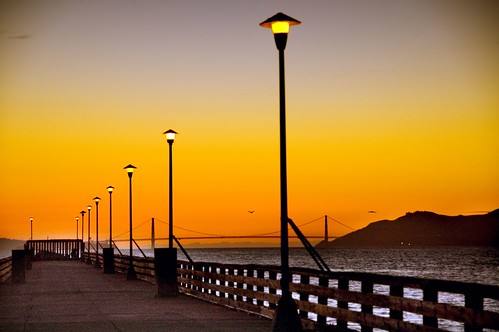I took this photograph during a session on the Berkeley Pier at sunset in January of 2006. This was one of the very last captures I made before the sun went down, and I remember thinking how interesting the street lights looked against the swiftly darkening sky.
When I reviewed the image on my computer I did not find it acceptable because the entire lower left quadrant had gone to black. In other words, there was far too much contrast between the light and dark areas in the photograph.
Fortunately, my post-processing skills have caught up with the way I saw the scene, and how I wanted the photograph to come out. The image you see here is the result of five different exposures from the RAW file blended together using layer masks, each layer with a different opacity, and with Normal, Screen, and Color blending mode used depending on the layer.
The five layers, each corresponding to an area in the image and each essentially representing a different exposure, are: general background (including the bridge and sky), water of the Bay including the Marin Hills, an intermediate layer for the pier fence, a layer corresponding to the darkest area of the pier, and a special layer for the street lamp lights.
For my money, the only problem with the finished image is that the layer exposed for the darkest area of the pier has a little too much color noise for my taste. Still, overall it came out pretty well.
My moral here is to hold that thought. With digital photography, if the concept behind an image is valid even if the execution is not, you should simply file the image away because there is always the chance that either the technology or your skill set will advance to a point where you can achieve the effect you wanted in the first place.
Since I’ve saved a version of the image with the multiple layers and masks in Photoshop, maybe someday I’ll figure out how to reduce that pesky color noise in the lower left!
